Abstract
Thirty volunteer subjects were exposed to controlled amounts of respirable dust generated by the carding of cotton in an experimental cardroom. Eighteen exposures each lasting six hours were performed while carding unwashed and washed cottons from the three major growing regions of the United States. Elutriated dust was analysed gravimetrically and was comparable (0.59 mg/m3 +/- 0.04) for all exposures. Spirometry was recorded before and after each exposure. California cotton resulted in a significantly smaller fall in FEV1 than cotton of the same grade from Texas or Mississippi. All washed cottons resulted in reduced declines when compared with unwashed cottons. For 17 subjects breathing zone personal total dust samples were analysed for airborne endotoxin and compared with the individual's pulmonary function response. A significant correlation between endotoxin exposure and acute decrease in FEV1 was seen. The effect on FEV1 per nanogram of airborne endotoxin was greater for Mississippi cotton than for cotton from the other regions. Airborne endotoxin appears to be an important determinant of acute pulmonary effects of cotton dust. Water washing of cotton results in reduced airborne endotoxin and less bronchoconstriction.
Full text
PDF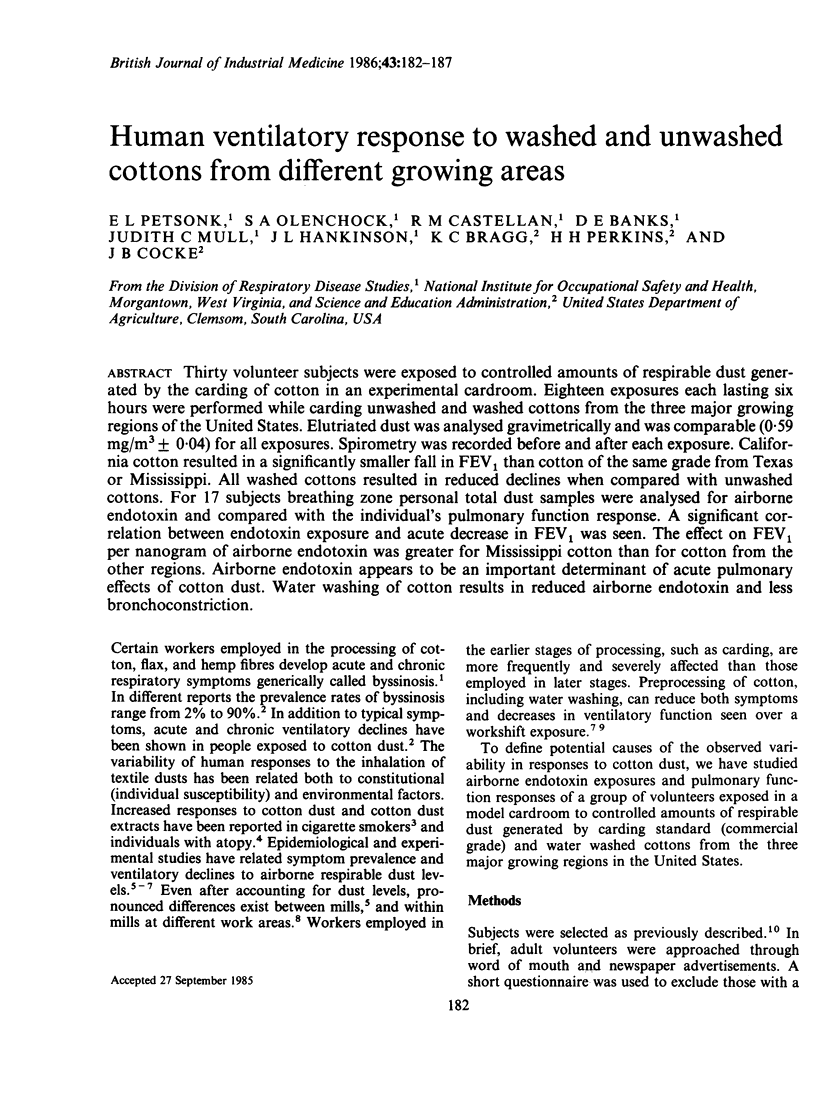
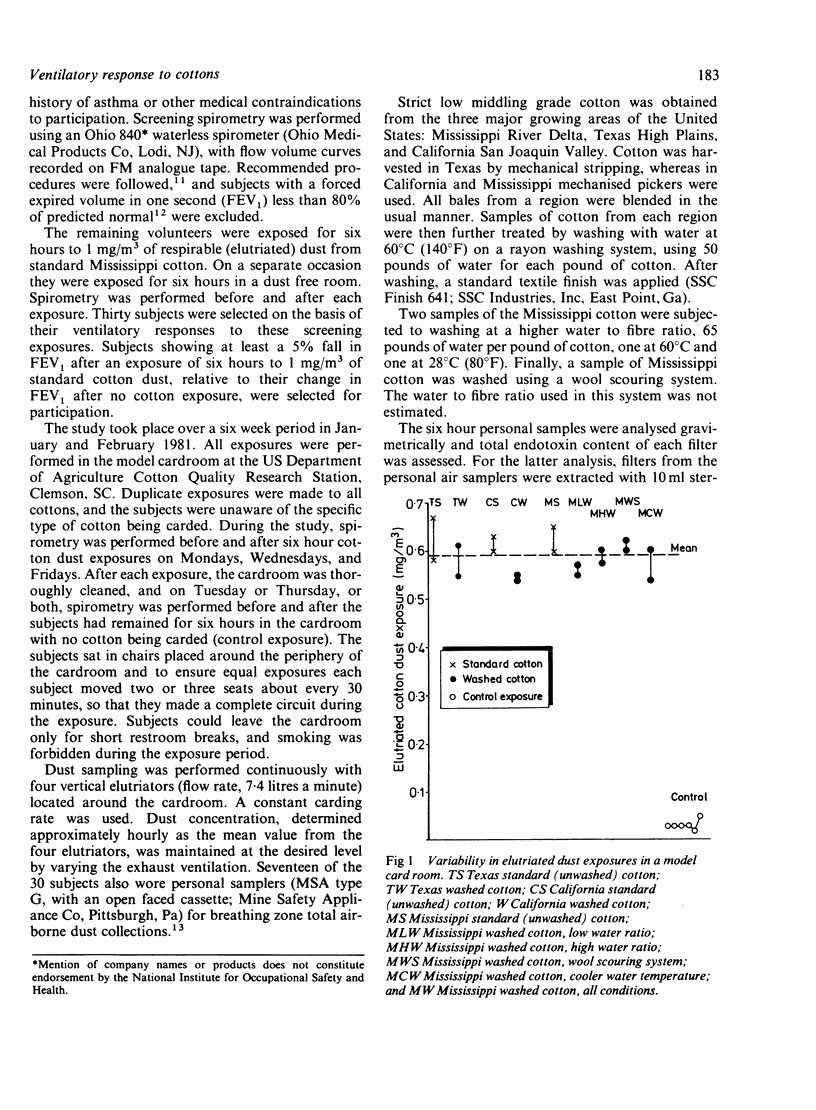
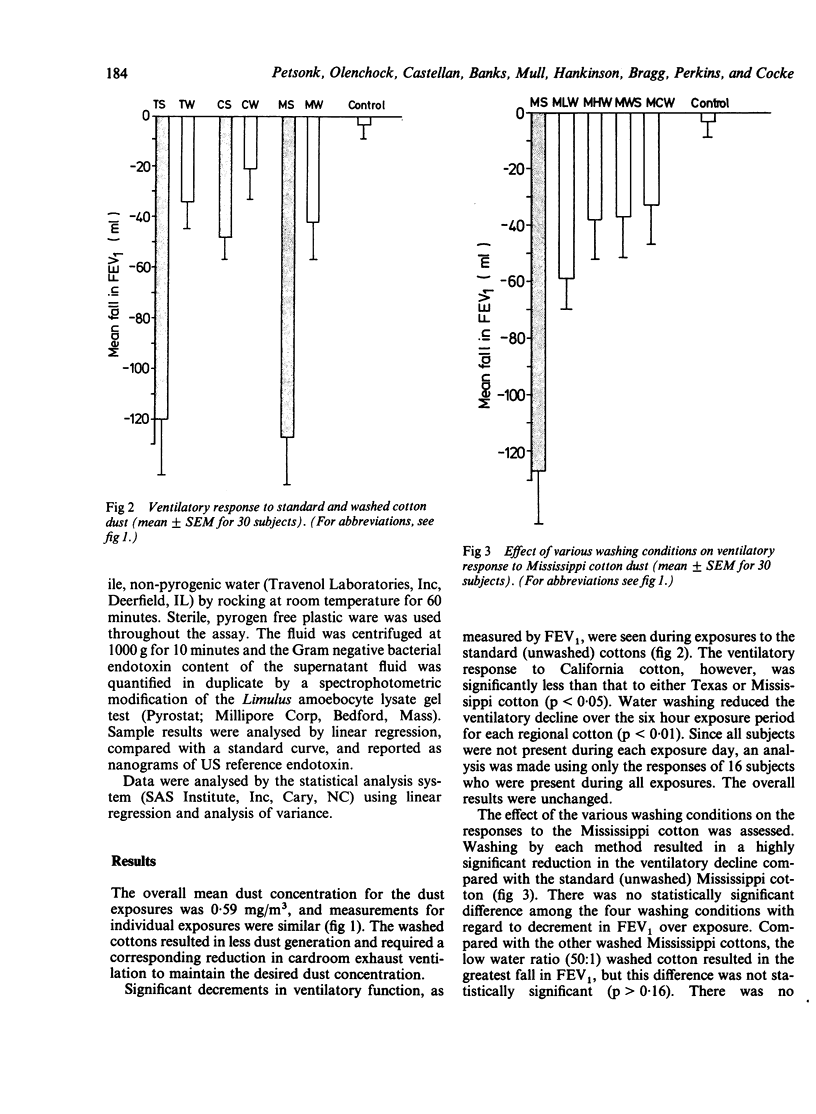
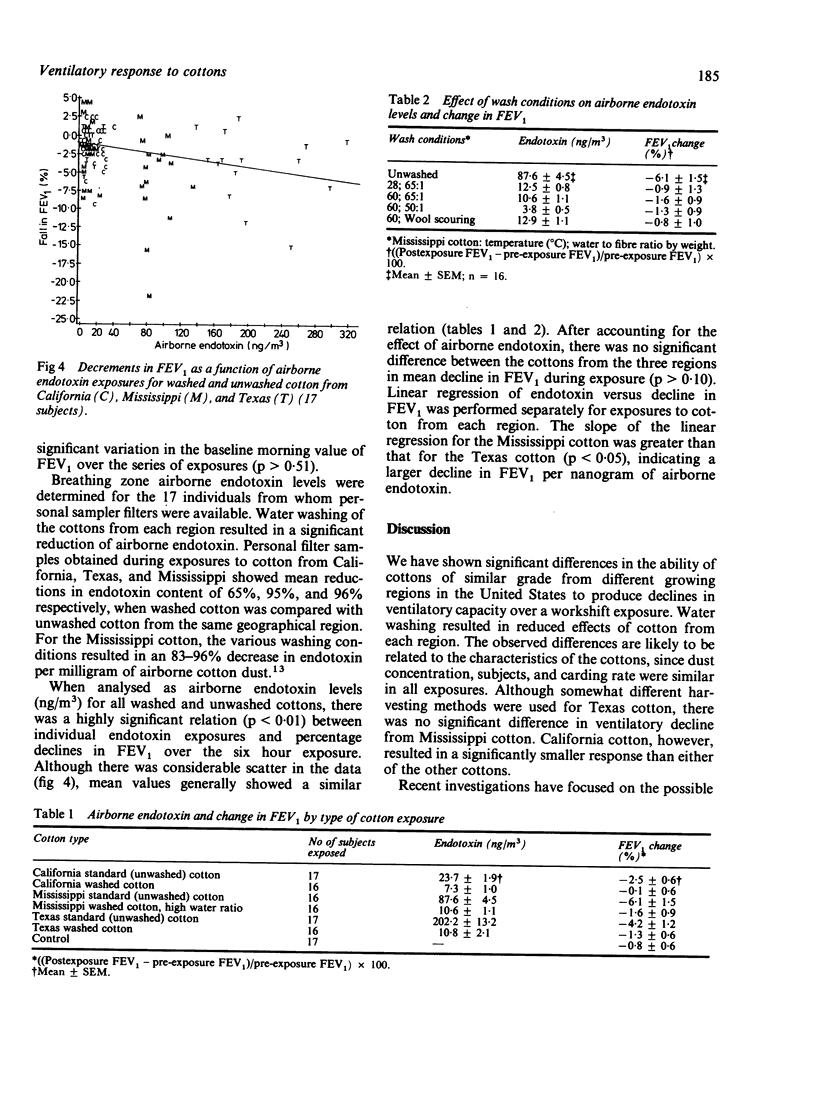
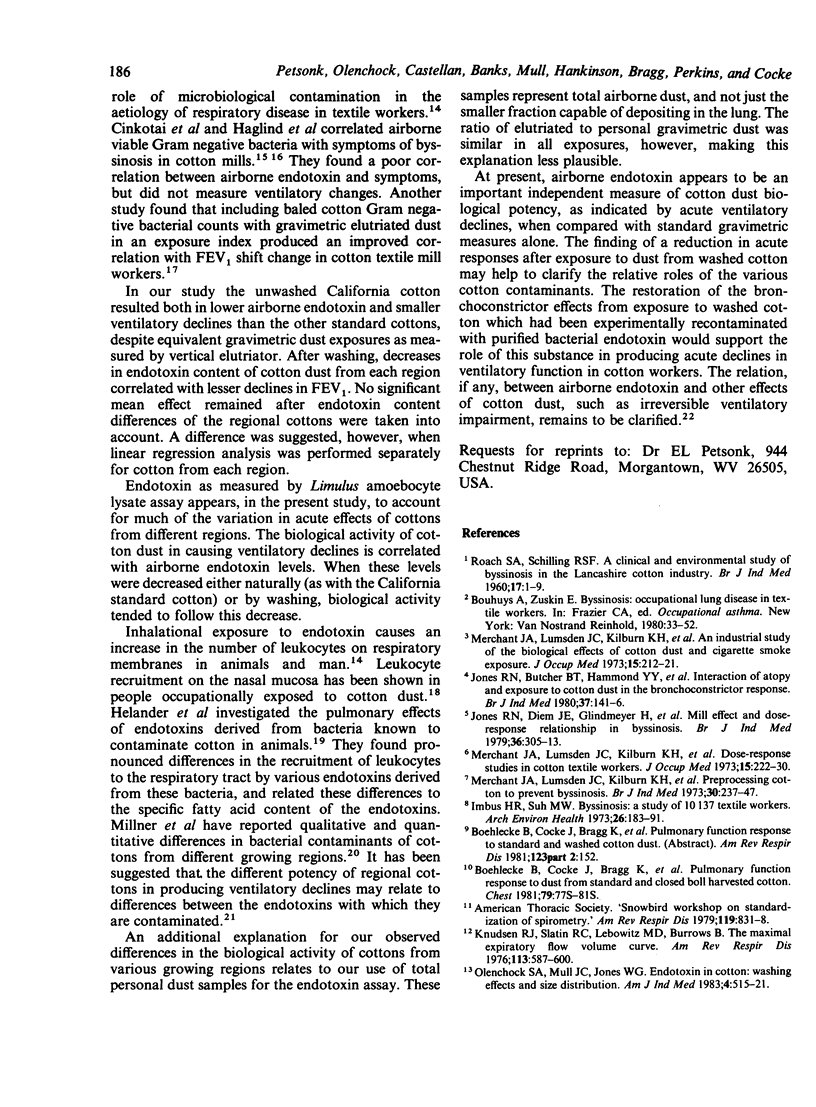
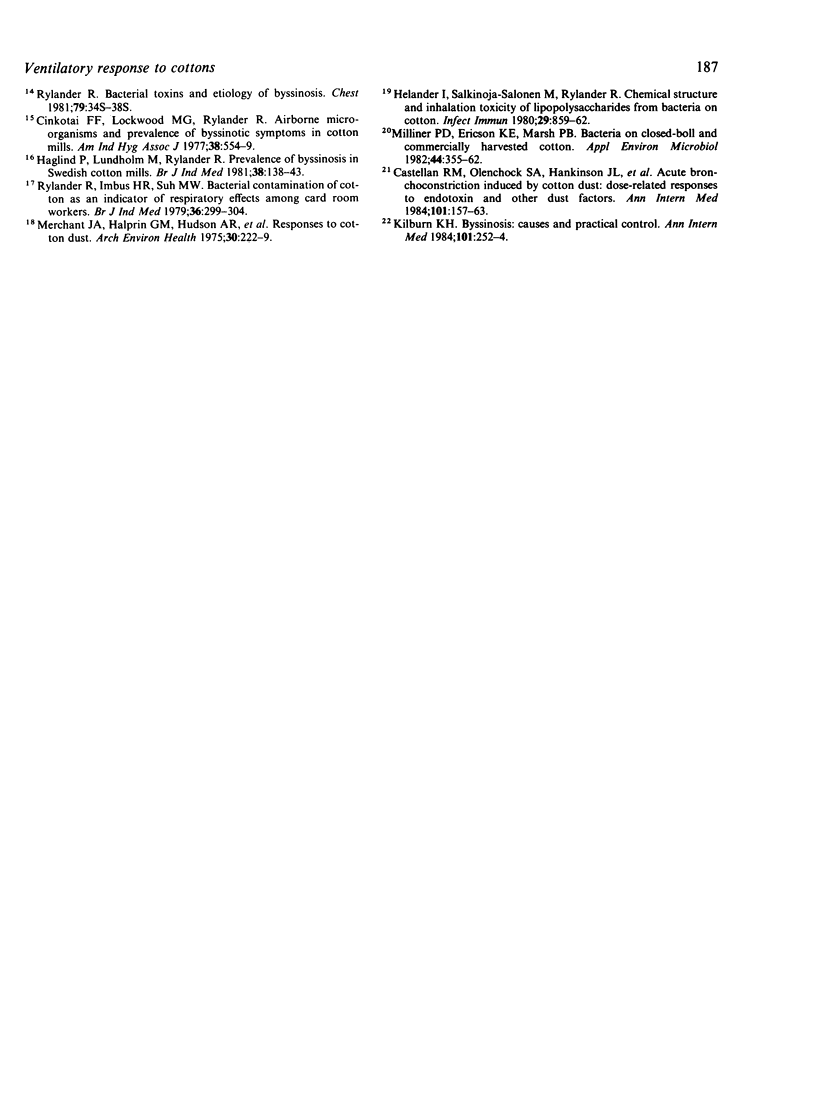
Selected References
These references are in PubMed. This may not be the complete list of references from this article.
- Boehlecke B., Cocke J., Bragg K., Hancock J., Petsonk E., Piccirillo R., Merchant J. Pulmonary function response to dust from standard and closed boll harvested cotton. Chest. 1981 Apr;79(4 Suppl):77S–81S. doi: 10.1378/chest.79.4_supplement.77s. [DOI] [PubMed] [Google Scholar]
- Castellan R. M., Olenchock S. A., Hankinson J. L., Millner P. D., Cocke J. B., Bragg C. K., Perkins H. H., Jr, Jacobs R. R. Acute bronchoconstriction induced by cotton dust: dose-related responses to endotoxin and other dust factors. Ann Intern Med. 1984 Aug;101(2):157–163. doi: 10.7326/0003-4819-101-2-157. [DOI] [PubMed] [Google Scholar]
- Cinkotai F. F., Lockwood M. G., Rylander R. Airborne micro-organisms and prevalence of byssinotic symptoms in cotton mills. Am Ind Hyg Assoc J. 1977 Oct;38(10):554–559. doi: 10.1080/0002889778507669. [DOI] [PubMed] [Google Scholar]
- Haglind P., Lundholm M., Rylander R. Prevalence of byssinosis in Swedish cotton mills. Br J Ind Med. 1981 May;38(2):138–143. doi: 10.1136/oem.38.2.138. [DOI] [PMC free article] [PubMed] [Google Scholar]
- Helander I., Salkinoja-Salonen M., Rylander R. Chemical structure and inhalation toxicity of lipopolysaccharides from bacteria on cotton. Infect Immun. 1980 Sep;29(3):859–862. doi: 10.1128/iai.29.3.859-862.1980. [DOI] [PMC free article] [PubMed] [Google Scholar]
- Imbus H. R., Suh M. W. Byssinosis: a study of 10,133 textile workers. Arch Environ Health. 1973 Apr;26(4):183–191. doi: 10.1080/00039896.1973.10666253. [DOI] [PubMed] [Google Scholar]
- Jones R. N., Butcher B. T., Hammad Y. Y., Diem J. E., Glindmeyer H. W., 3rd, Lehrer S. B., Hughes J. M., Weill H. Interaction of atopy and exposure to cotton dust in the bronchoconstrictor response. Br J Ind Med. 1980 May;37(2):141–146. doi: 10.1136/oem.37.2.141. [DOI] [PMC free article] [PubMed] [Google Scholar]
- Jones R. N., Diem J. E., Glindmeyer H., Dharmarajan V., Hammad Y. Y., Carr J., Weill H. Mill effect and dose-response relationships in byssinosis. Br J Ind Med. 1979 Nov;36(4):305–313. doi: 10.1136/oem.36.4.305. [DOI] [PMC free article] [PubMed] [Google Scholar]
- Kilburn K. H. Byssinosis: causes and practical control. Ann Intern Med. 1984 Aug;101(2):252–254. doi: 10.7326/0003-4819-101-2-252. [DOI] [PubMed] [Google Scholar]
- Knudson R. J., Slatin R. C., Lebowitz M. D., Burrows B. The maximal expiratory flow-volume curve. Normal standards, variability, and effects of age. Am Rev Respir Dis. 1976 May;113(5):587–600. doi: 10.1164/arrd.1976.113.5.587. [DOI] [PubMed] [Google Scholar]
- Merchant J. A., Halprin G. M., Hudson A. R., Kilburn K. H., McKenzie W. N., Hurst D. J., Bermazohn P. Responses to cotton dust. Arch Environ Health. 1975 May;30(5):222–229. doi: 10.1080/00039896.1975.10666685. [DOI] [PubMed] [Google Scholar]
- Merchant J. A., Lumsden J. C., Kilburn K. H., Germino V. H., Hamilton J. D., Lynn W. S., Byrd H., Baucom D. Preprocessing cotton to prevent byssinosis. Br J Ind Med. 1973 Jul;30(3):237–247. doi: 10.1136/oem.30.3.237. [DOI] [PMC free article] [PubMed] [Google Scholar]
- Merchant J. A., Lumsden J. C., Kilburn K. H., O'Fallon W. M., Ujda J. R., Germino V. H., Jr, Hamilton J. D. An industrial study of the biological effects of cotton dust and cigarette smoke exposure. J Occup Med. 1973 Mar;15(3):212–221. [PubMed] [Google Scholar]
- Merchant J. A., Lumsden J. C., Kilburn K. H., O'Fallon W. M., Ujda J. R., Germino V. H., Jr, Hamilton J. D. Dose response studies in cotton textile workers. J Occup Med. 1973 Mar;15(3):222–230. [PubMed] [Google Scholar]
- Millner P. D., Ericson K. E., Marsh P. B. Bacteria on closed-boll and commercially harvested cotton. Appl Environ Microbiol. 1982 Aug;44(2):355–362. doi: 10.1128/aem.44.2.355-362.1982. [DOI] [PMC free article] [PubMed] [Google Scholar]
- Olenchock S. A., Mull J. C., Jones W. G. Endotoxins in cotton: washing effects and size distribution. Am J Ind Med. 1983;4(4):515–521. doi: 10.1002/ajim.4700040405. [DOI] [PubMed] [Google Scholar]
- ROACH S. A., SCHILLING R. S. A clinical and environmental study of byssinosis in the Lancashire cotton industry. Br J Ind Med. 1960 Jan;17:1–9. doi: 10.1136/oem.17.1.1. [DOI] [PMC free article] [PubMed] [Google Scholar]
- Rylander R., Imbus H. R., Suh M. W. Bacterial contamination of cotton as an indicator of respiratory effects among card room workers. Br J Ind Med. 1979 Nov;36(4):299–304. doi: 10.1136/oem.36.4.299. [DOI] [PMC free article] [PubMed] [Google Scholar]


